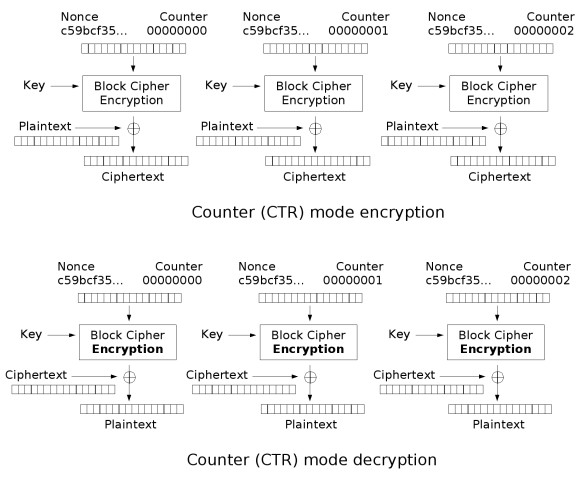AES CBC/CTR 加解密原理
So, lets look at how CBC works first. The following picture shows the encryption when using CBC (in this case, using AES as the cipher).

Basically, Cipher-Block-Chaining means that previous to putting the cleartext data block into the cipher itself (AES, DES, Triple-DES, …) it is XORed with the previous cipher block. This works fine for all but the first cleartext block, as – of course – there is no previous cipher block. So, the encrypting entity chooses a random value of block size (8bytes for DES, 16bytes for AES) to use in the first XOR. This value is the so-called Initialization Vector or IV. The following picture depicts the decryption using CBC.

Basically, the decryption works very similarily to encryption. This time, the ciphertext block is put through the decryption routine and is then XORed with the previous ciphertext block. Also, for the first block, we use the IV again. The important thing to understand at this point is the following. If, for some reason, we can deduce what comes out of the AES block in the first cipher (what is denoted here as the Intermediary Message (IM)), we can produce any “plain text” we want. Why can we do that? Well, CBC uses the IV to XOR the IM and we usually control this. So, for each byte of message we want to “generate”, we choose the IV as follows:
IV[n] = IM[n] ^ DesiredMessage[n]
If you wonder how you might deduce the IM, look up “padding oracles” on Google.
As both DES and AES are block ciphers, the length of the given input must always be a multiple of the block size. As messages might not fit this condition, the plaintext is padded to a multiple of block size. However, the decrypting entity must somehow know, how much padding was append to the original cleartext. There a multiple ways of doing this, we will focus on PKCS5 as it was needed in this challenge.
PKCS5 encodes a padding of n bytes by filling the all of the padded “slots” with n. Basically, if we have only one byte padding, the last byte will be 1. If we have e.g. 5 bytes padding, the last 5 bytes will all be set to 5. Please note, that padding must always be provided. Thus, if the message actually had a length which was a multiple of the block size, there will be exactly one block added to the message. For 8byte ciphers like DES, we then have a block of length 8b filled completely with 8s.
AES CBC加解密原理
CBC加解密原理如下图所示, 图片来源维基百科

CBC加密原理:明文跟向量异或,再用KEY进行加密,结果作为下个BLOCK的初始化向量。解密原理:使用密钥先对密文解密,解密后再同初始向量异或得到明文。
CBC需要对明文块大小进行Padding(补位),由于前后加密的相关性,只能实施串行化动作,无法并行运算。另外,CBC需要参量:密钥和初始化向量。
AES CTR加解密原理

CTR加密原理:用密钥对输入的计数器加密,然后同明文异或得到密文。解密原理:用密钥对输入计数器加密,然后同密文异或得到明文。
CTR不需要Padding,而且采用了流密钥方式加解密,适合于并行运算,CTR涉及参量:Nounce随机数、Counter计数器和密钥。Nounce随机数和Counter计数器整体可看作计数器,因为只要算法约定好,就可以回避掉串行化运算。
参考资料:
http://zh.wikipedia.org/wiki/高级加密标准
http://zh.wikipedia.org/zh/块密码的工作模式
AES CBC/CTR 加解密原理的更多相关文章
- Java 使用AES/CBC/PKCS7Padding 加解密字符串
介于java 不支持PKCS7Padding,只支持PKCS5Padding 但是PKCS7Padding 和 PKCS5Padding 没有什么区别要实现在java端用PKCS7Padding填充, ...
- python 实现 AES CBC模式加解密
AES加密方式有五种:ECB, CBC, CTR, CFB, OFB 从安全性角度推荐CBC加密方法,本文介绍了CBC,ECB两种加密方法的python实现 python 在 Windows下使用AE ...
- JAVA AES CBC PKCS5Padding加解密
package com.hzxc.groupactivity.util; /** * Created by hdwang on 2019/1/17. */ import org.slf4j.Logge ...
- C++ 和 java 使用 AES CBC 128 加解密
Java 使用jce, code: import javax.crypto.Cipher; import javax.crypto.spec.IvParameterSpec; import javax ...
- openssl:AES CBC PKCS5 加解密 (C/GOLANG)
#include <openssl/aes.h> /* AES_CBC_PKCS5_Encrypt * 入参: * src:明文 * srcLen:明文长度 * key:密钥 长度只能是1 ...
- 手机号的 AES/CBC/PKCS7Padding 加解密
前言:接口中上次的手机号码和密码是传入的加密的,模拟自动化的时候也需要先对数据进行加密 1.各种语言实现 网上已经各种语言实现好的AES加密,可以点击查看:http://outofmemory.cn/ ...
- node.js 实现 AES CTR 加解密
node.js 实现 AES CTR 加解密 node aesctr 前言 由于最近我们在做一款安全的文件分享 App, 所有文件均需要使用 aes ctr 来进行加密,aes key 还有一整套完整 ...
- python 实现 AES ECB模式加解密
AES ECB模式加解密使用cryptopp完成AES的ECB模式进行加解密. AES加密数据块分组长度必须为128比特,密钥长度可以是128比特.192比特.256比特中的任意一个.(8比特 == ...
- Spring Boot 实现配置文件加解密原理
Spring Boot 配置文件加解密原理就这么简单 背景 接上文<失踪人口回归,mybatis-plus 3.3.2 发布>[1] ,提供了一个非常实用的功能 「数据安全保护」 功能,不 ...
随机推荐
- 第5月第16天 php crud CodeIgniter CI_DB_active_record
1.C.R.U.D. Generator for CodeIgniter https://github.com/antonioyee/crud-generator/tree/9e5e48e773a52 ...
- Mysql字符集介绍
- 使用NSIS制作安装包
nsis下载地址:http://www.pc6.com/softview/SoftView_14342.html nsis使用: 启动NSIS程序主界面,选择“可视化脚本编辑器(VNISEdit)”菜 ...
- ASP.NET MVC + MySQL で開発環境構築
from:http://qiita.com/midori44/items/ef7cdd1d37c353e44b5f ASP.NET MVC & EntityFramework によるコードファ ...
- 从TFS 删除工作项
一.进入命令执行窗口的方式 1.若你的TFS服务器上安装了VS开发工作,可以按以下步骤,进入命令行方式,图如下: 2.若你TFS上没有安装VS开发工作,可以从你的开发机器上的VS安装目录下(一般情况下 ...
- 二、vue中组件的使用
1.组件拆分 1.组件实质上也是一个vue实例,因此组件中也可以使用vue的对象属性,反过来每一个vue实例也是一个vue组件(注:1.唯一不同的是el是根实例的特有选项,2.组件中的data必须是一 ...
- react-router 4 路由的嵌套
1.在component组件内部需要嵌套的位置直接嵌套Route标签 这个方法会使得路由标签比较分散,子组件我们必须直接将Route标签写入到父组件之中,而且路由必须包含根路径. // Dashboa ...
- jquery-事件之页面框架加载后自动执行
jQuery事件之页面框架加载后自动执行 1)概述 HTML执行是按自上而下编译,而<script>一般写在body结束之前.如果在HTML加载的过程中卡住, 比如加载图片等,没有显示出来 ...
- Top 10 Best Free Netflow Analyzers and Collectors for Windows
https://www.pcwdld.com/best-free-netflow-analyzers-and-collectors-for-windows https://blog.csdn.net/ ...
- flume修改配置文件
flume修改配置文件后,flume进程会自动将配置文件更新至服务中,同时会初始化日志,重新对于metrics进行记录的. 所以拿api做监控的同学要注意这点啦
